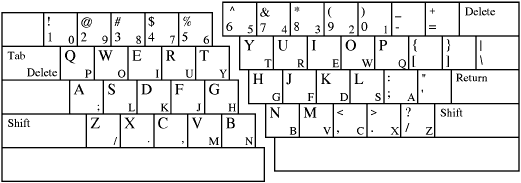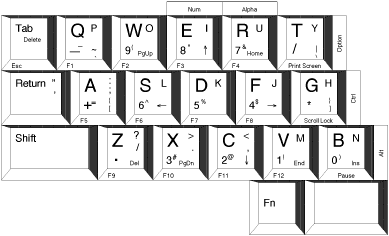Matias, E., MacKenzie, I. S., & Buxton, W. (1994). Half-QWERTY:
Typing with one hand using your two-handed skills. Companion of the
CHI '94 Conference on Human Factors in Computing Systems (pp. 51-52).
New York: ACM.
Half-QWERTY: Typing With One Hand
Using Your Two-handed Skills
Edgar Matias
The Matias Corporation
178 Thistledown Boulevard
Rexdale, Ontario, Canada M9V 1K1
(416) 749-3124
ematias@dgp.toronto.edu
I. Scott MacKenzie
Dept. of Computing and Information Science
University of Guelph
Guelph, Ontario, Canada N1G 2W1
(519) 824-4120
mac@snowhite.cis.uoguelph.ca
William
Buxton
University of Toronto & Xerox PARC
c/o Computer Systems Research Institute
University of Toronto
Toronto, Ontario, Canada M5S 1A4
(416) 978-1961 buxton@dgp.toronto.edu
Abstract
Half-QWERTY is a new one-handed typing technique, designed to facilitate
the transfer of two-handed typing skill to the one-handed condition. It
is performed on a standard keyboard (with modified software), or a special
half keyboard (with full-sized keys). Experiments have shown [2]
that it is possible for QWERTY touch-typists to achieve high one-handed
typing rates (40+ wpm) in a relatively short period of time (<10 hr)
using the Half-QWERTY technique. These speeds are 2-3 times the rates achievable
using compact keyboards, and exceed handwriting speeds. Half-QWERTY is
important in providing access to disabled users, and for the design of
compact computers.
Keywords:
Input devices, input tasks, human performance, one-handed keyboard, QWERTY,
portable computers, disabled users, skill transfer.
What Is It? {1}
This Interactive Experience display demonstrates a new approach to one-handed
text entry which exploits the skills already developed in two-handed typing.
It is called, "Half-QWERTY," because it uses only half of the QWERTY keyboard.
The technique can be used on a standard QWERTY keyboard (using only half
of the available keys, Figure 1), or with a special half keyboard (Figure
2). The former provides wide access to the technique. The latter provides
a compact keyboard with full-sized keys supporting touch typing on portable
computers, for example.

Figure 1. Left- and right-hand Half-QWERTY layouts on a standard
QWERTY keyboard. When a key is depressed, the character in the upper left
of the key is entered. When preceded by holding down the space bar, the
character in the lower right is entered.

Figure 2. Wearable left-hand right-wrist keyboard (actual size).
It is typed on using the left hand while worn on the right wrist. If an
LCD is worn on the left wrist, the resulting typing posture allows the
user to type and view the display, simultaneously. [N.B.: Pictures of a
prototype are available
online]
How Does It Work?
A Half-QWERTY keyboard is comprised of all the keys used by one hand to
type on a standard QWERTY keyboard, with the keys of the other hand unused
or absent. Keys of the typing hand are typed as before. To type characters
of the missing hand, the user simply holds down the space bar and performs
the finger movement previously done by the missing hand (Figure 1). Thus,
using the space bar as a modifier, a typist can generate the characters
of either side of a full-sized keyboard, using only one hand.
How Will It Be Used?
Half-QWERTY is especially useful when performing tasks which require frequent
switching between keyboard and mouse--text editing, for example. Text can
be entered with one hand, and items selected and manipulated with the other.
Since both hands are in "home position" for their respective task, no time
is lost in moving between devices [1].
Furthermore, by implementing Half-QWERTY on a standard keyboard, one can
easily switch between this type of input and two-handed typing. Finally,
since each side of the keyboard is mapped onto the other side when the
space bar is depressed, the user can choose which hand to use for one-handed
typing. In effect, the user has a choice of three keyboards in one: a two-handed
QWERTY keyboard, and two Half-QWERTY keyboards, one for each hand.
A computer that is worn, rather than carried, has significant advantages
for data collection "in the field." By eliminating infrequently used keys
(e.g., the number keys) and reducing the size of the space bar, a Half-QWERTY
keyboard can be made small enough to wear on the wrist of the dominant
hand (Figure 2). With an LCD screen worn on the other wrist, the resulting
typing posture allows the user to type and view the display, simultaneously.
[N.B.: Pictures of a prototype are available
online]
Acknowledgements
We gratefully acknowledge the support of the Natural Sciences and Engineering
Research Council of Canada, Digital Equipment Corporation, Xerox Palo Alto
Research Centre (PARC), Apple Computer's Human Interface Group, IBM Canada's
Toronto Laboratory Centre for Advanced Studies, and the Arnott Design Group
of Toronto.
References
[1]Engelbart, D., & English,
W. K. (1968). A research center for augmenting human intellect. Proceedings
of the Fall Joint Computer Conference (pp. 395-410). Washington, DC:
Thompson Book Co.
[2]Matias, E., MacKenzie,
I. S., & Buxton, W. (1993). Half-QWERTY: A one-handed keyboard facilitating
skill transfer from QWERTY. Proceedings of the INTERCHI '93 Conference
on Human Factors in Computing Systems (pp. 88-94). New York: ACM. Available
online (153K).
Footnotes
{1}Patents pending.
International Application # PCT/CA90/00274 published March 21, 1991, under
International Publication # W091/03782.


